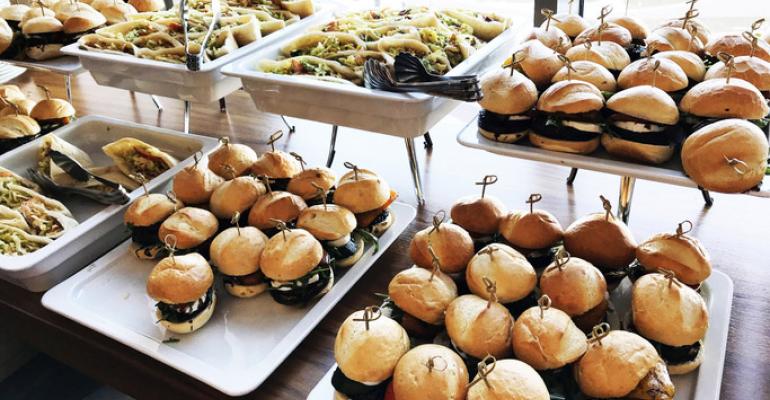It's important to take time to understand the role event professionals can play in slowing the climate crisis. While many elements of the planning process should be considered, food and beverage decisions are critical.
Based on 2016 figures from the Events Industry Council’s Economic Significance of Meetings to the U.S. Economy, food and beverage is, by far, the top planning and production expense for events: $48 billion per year (15 percent more than audiovisual costs). If you add in the $16 billion spent on food and beverage by participants and organizers getting to and from the 1.9 million meetings held annually, total F&B spending climbs to $64 billion
Reducing your events’ food footprint may seem daunting, but you have to start somewhere. Here are six strategies that can make an impact on climate change, attendee health, and your budget.
1. Count, count, and recount. Analyze your history: How many people actually attend each food function? Inaccurate head counts are a huge waste of food and money. While you may have 1,000 attendees, if only 25 percent historically show up, there’s no sense in ordering food for empty seats. To help get it right, ask attendees during registration which functions they plan to attend. This won’t be 100 percent accurate, but it will probably be close. And remember, your F&B minimum is not solely based on the head count. If you upgrade the food offerings while reducing your head count, you can still meet your minimums.
2. Understand food needs and preferences. Ask attendees about their dietary needs and preferences during registration. Knowing this information in advance gives chefs the opportunity to design menus that meet those needs. That, in turn, can reduce the number of personalized plates that need to be made.
Also, pay attention to foods you’ve served at past events that everyone preferred or avoided. No sense in ordering tons of croissants, for example, if your attendees only grab fruit and yogurt for breakfast.
3. Service style matters. Seated and served plated meals are certainly the least wasteful of all service styles. Buffets, while sometimes necessary, are the most wasteful. To reduce buffet waste, change the self-serve, all-you-can-eat design, make it an attendant-served buffet or have actions stations, where an attendant carves, sautes, or mixes the servings. Other low-waste ideas include butler-passed items, buffets with tapas/small plates, and family-style seated meals featuring serving dishes on each table.
4. Consider plant-based menus. There’s a massive difference in the greenhouse gas emissions to put beef on the table versus pork or chicken, and an even greater difference for plant-based meals. While you might think that menus with minimally processed, mostly vegetarian foods are a non-starter for your “steak-and-potatoes” attendees, you might be surprised. Survey them ahead of time on a range of non-meat items to see what they would prefer, and even ask for suggestions.
The increase in people eating more plant-based items is notable. According to the International Food Information Council’s 2021 Food & Health Survey, 25 percent of people are eating more plant-based proteins than a year ago. In 2020, the same report showed that 25 percent of consumers are actively seeking out foods or follow a diet for health benefits, while more than half say the healthfulness of a food impacts their food choices.
5. Reduce portion sizes. According to Menus of Change, Principles of Healthy Sustainable Menus, a collaborative report from Harvard’s T.H. Chan School of Public Health and the Culinary Institute of America, “moderating portion size is one of the biggest steps foodservice operators can take towards reversing obesity trends and reducing food waste.” Additionally, the 2021 IFIC report shows that consumers think the number-one element of “healthy eating pattern” is eating appropriate portion sizes at each meal.
For meeting planners who worry that attendees will notice smaller portion sizes and feel they aren’t getting what they paid for, the World Wildlife Fund’s “Toolkit for Communicating Food Waste to Guests” has three suggestions:
• “emphasize the quality of what they’re eating”
• “create a sense of indulgence through variety and experience, and by equating sustainability with luxury”
• “emphasize exploration through variety, not quantity—taking less means you can try more and savor it.”
6. Recover Leftover Food. Even planners who work to get their quantities right can find that a lot of food goes uneaten. Take time to plan ahead for recovering that food and donating it to local organizations that feed people in the community. Food insecurity has skyrocketed because of the Covid pandemic, so the need is greater than ever.
Before you contract with a catering partner, talk to them about who they work with in the community. Alternatively, find an organization yourself and partner with them. Contracts should include who the food will go to and how it will be handled; be sure to follow up to make sure the donations are being planned for in advance and throughout the event.
Tracy Stuckrath is president and founder of thrive! meetings & events.





